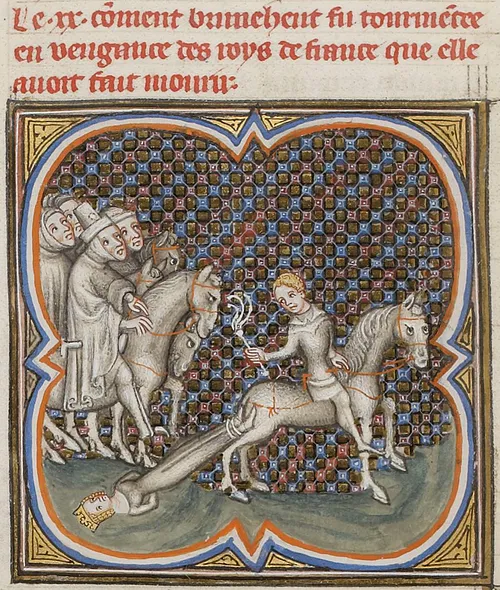ShareIn 575, Brunhilda and Sigebert's son Childebert II (r. 575-596) ascended to the throne at age five. Brunhilda served as the young king's regent, effectively becoming the true power behind the throne of Austrasia. The discontented Austrasian nobles resisted Brunhila's rule, but Brunhilda convinced King Guntram of Orléans to support her, granting the queen the legitimacy she needed. As a competent and focused leader, Brunhilda set about repairing old roads from the time of the Romans, building churches, constructing fortresses, reorganizing the kingdom's budget, and restructuring the Austrasian army. Though she was opposed by the Austrasian nobility at every turn, Guntram's adoption of Childebert II as his heir only added to her authority's legitimacy.
By 584, Childebert had reached the age of majority, but Brunhilda still maintained some power behind the throne. Three Austrasian dukes opposed Brunhilda's influence and decided to assassinate Childebert. The plot was exposed and one of the dukes was slain. The two other dukes retreated to a fortress only to be crushed by the forces of Orléans. After the insurrection, Orléans and Austrasia signed the Pact of Andelot in which it was codified that, upon the death of King Guntram, Childebert would ascend to the throne of Orléans and unite it with Austrasia. This was another power play by Brunhilda as it effectively blocked Fredegund's puppet son King Chlothar II of Neustria (r. 584-613) from inheriting the throne of Orléans.
Guntram died in 592, and as per the Pact of Andelot, Childebert II became king of Orléans (which was gradually becoming known as Burgundy, the name of a Germanic kingdom that once stood in the region). Naturally, war broke out between Austrasia-Burgundy, puppeted by Brunhilda, and Neustria, puppeted by Fredegund. A notable battle from this war was the Battle of Droizy in 593 where Fredegund directly led Neustrian forces to victory against Brunhilda's Austrasia-Burgundian soldiers. (Read more.)
Tota pulchra es Maria
1 day ago


















No comments:
Post a Comment